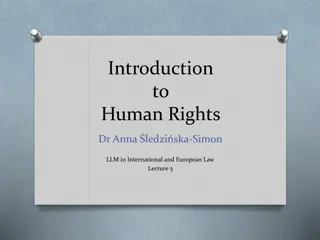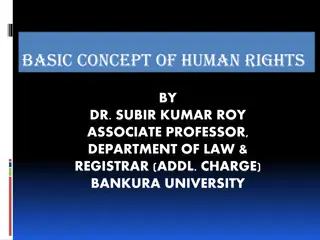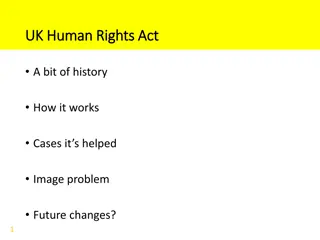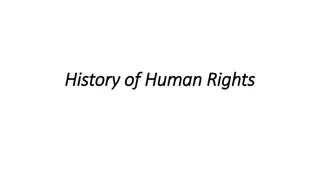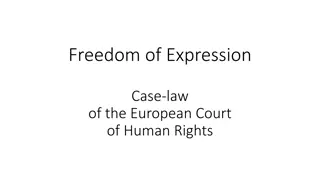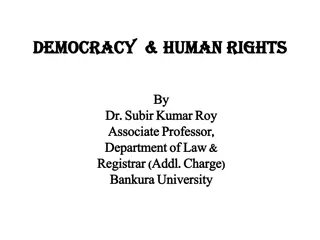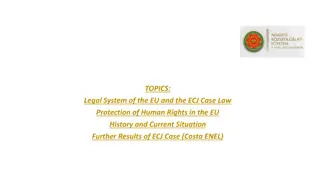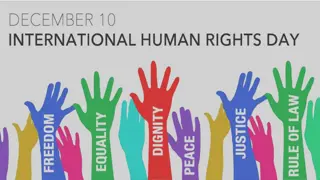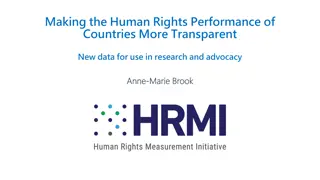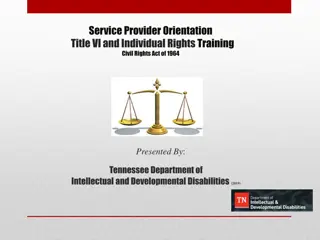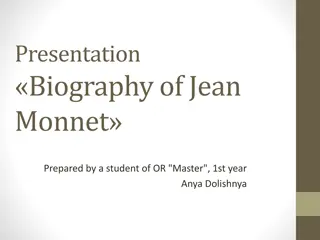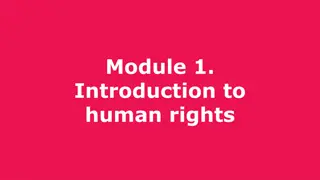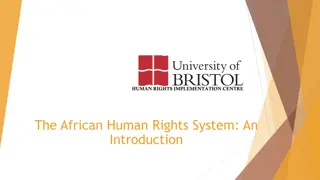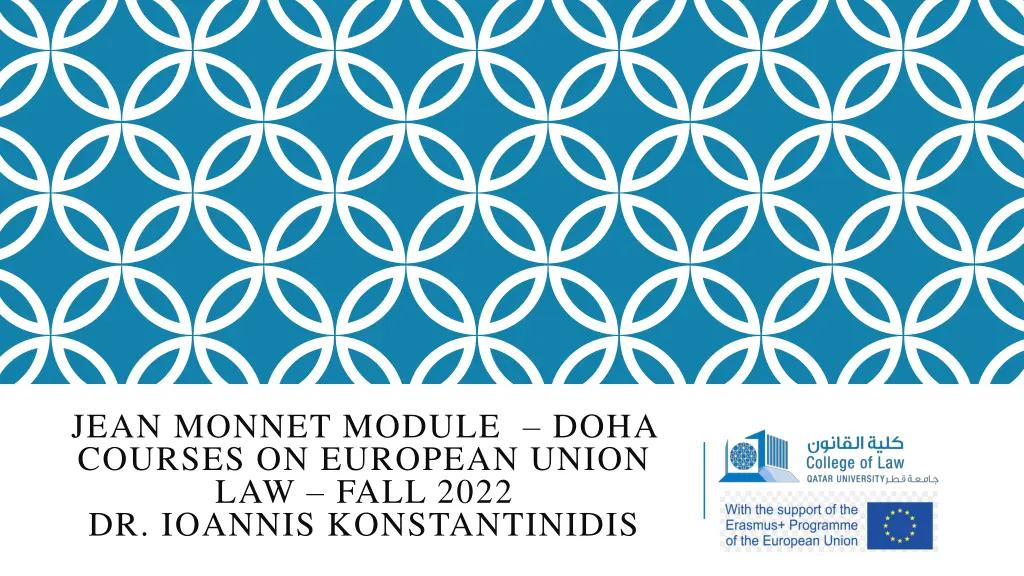
Understanding EU Charter of Fundamental Rights: Drafting, Structure, and Importance
Explore the significance of the European Union Charter of Fundamental Rights, its drafting process, and structural elements. Discover why its adoption marks a crucial constitutional milestone in EU history, incorporating rights from various sources into a coherent framework.
Download Presentation

Please find below an Image/Link to download the presentation.
The content on the website is provided AS IS for your information and personal use only. It may not be sold, licensed, or shared on other websites without obtaining consent from the author. If you encounter any issues during the download, it is possible that the publisher has removed the file from their server.
You are allowed to download the files provided on this website for personal or commercial use, subject to the condition that they are used lawfully. All files are the property of their respective owners.
The content on the website is provided AS IS for your information and personal use only. It may not be sold, licensed, or shared on other websites without obtaining consent from the author.
E N D
Presentation Transcript
JEAN MONNET MODULE DOHA COURSES ON EUROPEAN UNION LAW FALL 2022 DR. IOANNIS KONSTANTINIDIS
COURSE 2: THE EU CHARTER OF FUNDAMENTAL RIGHTS WEEK 5 I. The Drafting and Structure of the Charter II. The Substantive Provisions and the Scope of Application/Interpretation of the EU Charter III. Concluding Remarks
WEEK 5 Learning Outcomes: On completion of this week, students should Have developed an advanced understanding of the EU Charter of Fundamental Freedoms
I. THE DRAFTING AND STRUCTURE OF THE EU CHARTER The European Union Charter of Fundamental Rights (EU Charter)
I. THE DRAFTING AND STRUCTURE OF THE EU CHARTER The European Union Charter of Fundamental Rights (EU Charter)
I. THE DRAFTING AND STRUCTURE OF THE EU CHARTER The Importance of Adopting the EU Charter The adoption of the EU Charter is one of the most significant constitutional steps in the history of the EU: Why? 1. The Charter was drafted using a new (and some might say revolutionary) procedure which involved not only representatives of national governments but also representatives of national and European parliaments
I. THE DRAFTING AND STRUCTURE OF THE EU CHARTER The Importance of Adopting the EU Charter The adoption of the EU Charter is one of the most significant constitutional steps in the history of the EU: Why? 2. The fact that Member States felt the need to adopt a fundamental rights document (even though there is no general fundamental rights competence for the EU), is a further step in the long process of the constitutional evolution of the EU
I. THE DRAFTING AND STRUCTURE OF THE EU CHARTER The Cologne EU Council of 1999 and Its Conclusions Charter should contain: A. The rights and procedural guarantees contained in the ECHR and those derived by the common constitutional traditions, as general principles of European law B. The rights pertaining to Union citizens (e.g. right to move and reside in Member States) C. Account was to be taken of the social rights contained in the European Social Charter and the Community Charter of the Fundamental Social Rights of Workers
I. THE DRAFTING AND STRUCTURE OF THE EU CHARTER The Cologne EU Council of 1999 and Its Conclusions Body in charge of drafting the EU Charter: A. Representatives of the heads of state and government B. President of the Commission C. Representatives of national parliaments D. Members of the European Parliament
I. THE DRAFTING AND STRUCTURE OF THE EU CHARTER The Cologne EU Council of 1999 and Its Conclusions Treaty drafting novelty? Normally international treaties are drafted and negotiated by representatives of national governments and are then presented to national parliaments for ratification Given the fundamental importance of the document to be drafted, the Member States decided to include in the discussions representatives of directly elected parliaments hence enhancing the democratic credentials of the drafting body
I. THE DRAFTING AND STRUCTURE OF THE EU CHARTER The Tampere EU Council of 1999 15 representatives of the heads of state or government of the Member States 1 representative of the Commission 16 representatives of the European Parliament 30 representatives of the national parliaments (two for each Member State)
I. THE DRAFTING AND STRUCTURE OF THE EU CHARTER Negotiations Leading to the Adoption of the EU Charter Democratic legitimacy: all documents were made public and placed on the internet Acceding Member States as well as non-governmental organizations (NGOs) were allowed to participate
I. THE DRAFTING AND STRUCTURE OF THE EU CHARTER Negotiations Leading to the Adoption of the EU Charter 10 months to draft the EU Charter It was proclaimed by the European Parliament, the Commission and the Council on 7 December 2000 in Nice (France) Initially, the EU Charter was not legally binding Issue settled by the Treaty of Lisbon (Article 6(1))
I. THE DRAFTING AND STRUCTURE OF THE EU CHARTER A Novel Structure? Departure from the traditional dichotomy of civil and political rights/economic and social rights It approaches fundamental rights as an individual whole EU Charter is divided into titles according to six fundamental values: dignity, freedom, equality, solidarity, citizens rights, and justice
I. THE DRAFTING AND STRUCTURE OF THE EU CHARTER A Novel Structure? They are complemented by a preamble and the so-called horizontal provisions: General provisions (scope of application of the Charter), the legitimate grounds of limits on, and derogations from, Charter rights, as well as the relationship with the ECHR, national constitutions, and international human rights treaties
I. THE SUBSTANTIVE PROVISIONS AND THE SCOPE OF APPLICATION / INTERPRETATION OF THE EU CHARTER itle I: Dignity Article 1-5 Title I contains those rights which are essential to the enjoyment of any other right: the right to human dignity; the right to life; the right to the integrity of the person, which contains new generation rights such as the principle of informed consent in relation to medical intervention; the prohibition of torture and inhuman and degrading treatment; and the prohibition of slavery and forced labor
I. THE SUBSTANTIVE PROVISIONS AND THE SCOPE OF APPLICATION / INTERPRETATION OF THE EU CHARTER itle II: Freedom Articles 6-19 This title contains some of the traditional civil and political rights: right to liberty; the right to private life; the right to freedom of expression; the right to property Some new generation rights: the right to protection of personal data Some socio-economic rights, such as the right to work and the right to education
I. THE SUBSTANTIVE PROVISIONS AND THE SCOPE OF APPLICATION / INTERPRETATION OF THE EU CHARTER itle II: Freedom Articles 6-19 Comment: It is interesting to note that despite the Charter s ambitions to reflect a more contemporary take on rights, the right to freedom of thought and religion was not broadened explicitly to include the right not to hold a religious belief, as suggested by many NGOs
I. THE SUBSTANTIVE PROVISIONS AND THE SCOPE OF APPLICATION / INTERPRETATION OF THE EU CHARTER itle III: Equality Articles 20-26 Title III contains traditional equality rights (non-discrimination on grounds of sex, race, sexual orientation, religion, belief, etc.) It also provides for the right not to be discriminated against on grounds of nationality within the scope of application of the Treaty and the rights of more vulnerable members of society such as children, the elderly, and disabled people
I. THE SUBSTANTIVE PROVISIONS AND THE SCOPE OF APPLICATION / INTERPRETATION OF THE EU CHARTER itle IV: Solidarity Articles 27-38 Title IV was the most contested part of the EU Charter in certain EU members Traditional social rights and principles , such as the right to collective bargaining and action, including the right to strike and protection against unjustified dismissal; the right to fair working conditions as well as protection for children and young people at work, and protection for the family, including protection against dismissal linked to maternity
I. THE SUBSTANTIVE PROVISIONS AND THE SCOPE OF APPLICATION / INTERPRETATION OF THE EU CHARTER itle IV: Solidarity Articles 27-38 It also includes recognition of social security and social assistance; access to services of general economic interests; and the right to health care, as well as the obligation for the Union to ensure a high level of environmental and consumer protection in its policies
I. THE SUBSTANTIVE PROVISIONS AND THE SCOPE OF APPLICATION / INTERPRETATION OF THE EU CHARTER itle V: Citizens Rights Articles 39-46 This article benefits mainly EU citizens It includes the right to vote and stand for elections in the European Parliament and in municipal elections in the Member State of residence, the right to move and reside freely in the territory of the Member States, and the right to consular and diplomatic protection, all limited to Union citizens
I. THE SUBSTANTIVE PROVISIONS AND THE SCOPE OF APPLICATION / INTERPRETATION OF THE EU CHARTER itle V: Citizens Rights Articles 39-46 The administrative rights in this title, such as the right to good administration, the right to access documents, the right to complain to the Ombudsman, and the right to petition, are also available to non-EU citizens residents
I. THE SUBSTANTIVE PROVISIONS AND THE SCOPE OF APPLICATION / INTERPRETATION OF THE EU CHARTER itle VI: Justice Articles 47-50 Title VI is concerned with the administration of justice and draws mainly on the ECHR and on the common constitutional traditions to the Member States It includes the right to an effective remedy and a fair trial; the right to be presumed innocent and the right of defence; the principle of legality and proportionality of criminal offences and penalties; and the principle of ne bis in idem, which is to say the right not to be tried or punished twice for the same offence
I. THE SUBSTANTIVE PROVISIONS AND THE SCOPE OF APPLICATION / INTERPRETATION OF THE EU CHARTER Article 51: EU Charter Scope of Application The EU Charter codifies existing case law making rights more visible to the citizen. Its primary addressee, then, is the EU Member States are also bound by EU fundamental rights when they exercise a discretion which has either been conferred by Union law (i.e. when they implement a Union law instrument) or when they bring themselves within the scope of EU law by limiting or derogating from one of the rights conferred by the Treaties
I. THE SUBSTANTIVE PROVISIONS AND THE SCOPE OF APPLICATION / INTERPRETATION OF THE EU CHARTER Article 51: EU Charter Scope of Application Article 51(1) therefore states that the provisions of the Charter are addressed to the EU Institutions, agencies, and bodies and to the Member States only when they implement Union law What constitute implementation for the purposes of Article 51(1) It covers cases in which the Member State is implementing or giving effect to a directive, regulation, or decision, as well as cases where the Member State is limiting one of the rights granted by the Treaty
I. THE SUBSTANTIVE PROVISIONS AND THE SCOPE OF APPLICATION / INTERPRETATION OF THE EU CHARTER Article 51: EU Charter Scope of Application Case klagaren v. Hans kerberg Fransson Several intervening Member States, together with the Commission, argued that the Charter was not applicable since the legislation which formed the basis for the proceedings was not implementing EU law
I. THE SUBSTANTIVE PROVISIONS AND THE SCOPE OF APPLICATION / INTERPRETATION OF THE EU CHARTER Article 52: EU Charter Scope of Interpretation Very few fundamental rights are absolute The vast majority of fundamental rights can be limited in order to protect the rights of others and/or to ensure that public policy objectives can be carried out
I. THE SUBSTANTIVE PROVISIONS AND THE SCOPE OF APPLICATION / INTERPRETATION OF THE EU CHARTER Article 52: EU Charter Scope of Interpretation The Charter provides for just one general derogation and limitation clause. Article 52(1) states that limitations on the exercise of Charter rights must: be provided by law; respect the essence of those rights; respect the principle of proportionality; and be necessary to meet the objectives of general interest recognized by the Union or the need to protect the rights and freedoms of others
I. THE SUBSTANTIVE PROVISIONS AND THE SCOPE OF APPLICATION / INTERPRETATION OF THE EU CHARTER Article 52: EU Charter Scope of Interpretation Note on Article 53:`this Article ensures that the protection afforded by the Charter cannot fall below that afforded by international law and international agreements to which the EU or all of the Member States are parties, including the ECHR, and by the Member States constitutions
III. CONCLUDING REMARKS Whether the EU Charter will open a new era in the development of the EU from limited economic cooperation to a full political, economic, and social union remains to be seen Future practice and case law of the European Court of Justice will provide more answers
NEXT WEEK: - THE EUROPEAN UNION AND THE EUROPEAN CONVENTION ON HUMAN RIGHTS - EUROPEAN UNION EXTERNAL ACTION AND HUMAN RIGHTS Readings Per the course syllabus


